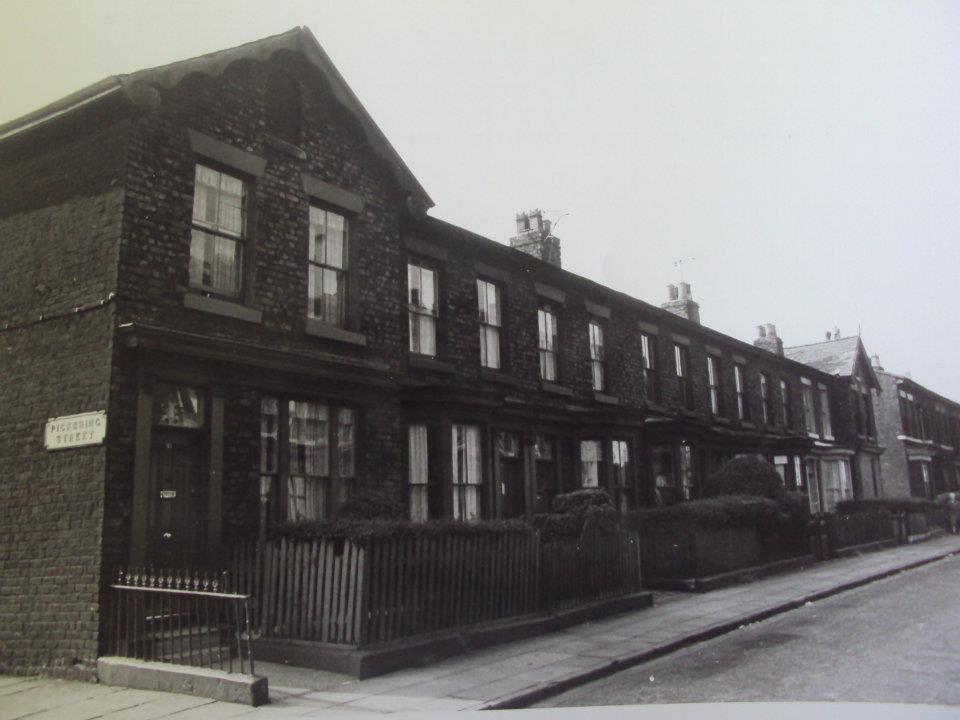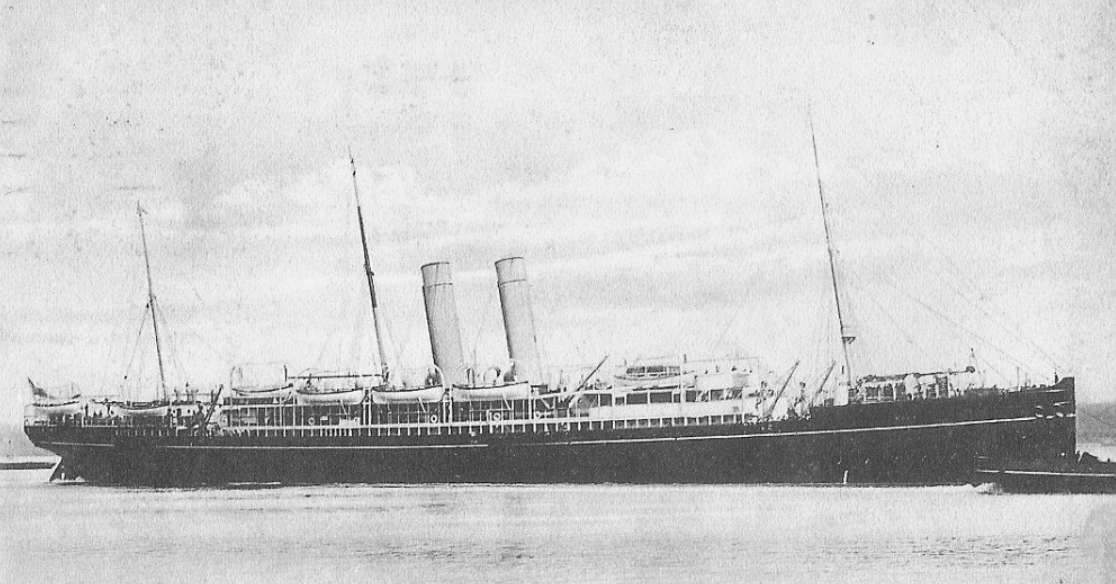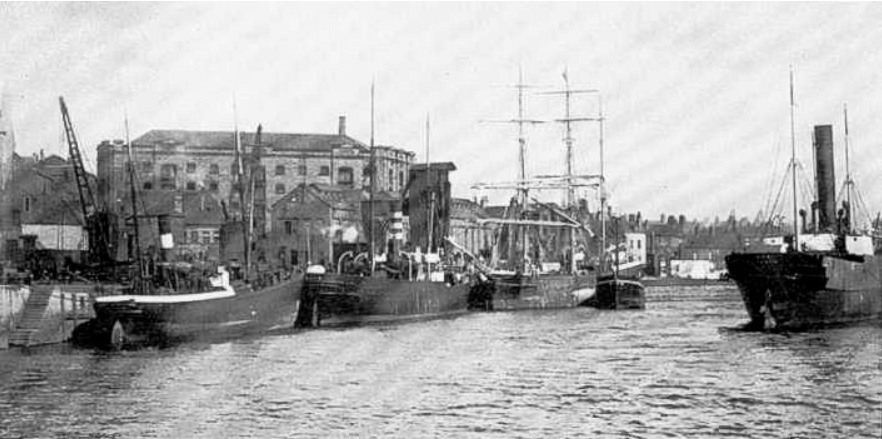Military unit: H.M.T. “Dee” Mercantile Marine
Date & place of birth: 15 May 1870 at Everton, Lancashire
Date & place of death: 10 August 1918, aged 48 at Suez, Egypt
Frederick Eccleston was a master mariner who died when he fell from a gangway and was drowned.
Family
Frederick George Porter Eccleston was born at 55 St Albans, Everton on 15 May 1870, the elder of two sons born to John Eccleston (1834–1912) and his wife Elizabeth Ann née Grave (1845–1883).
John Ecclestone was originally from Newport, Shropshire where he lived until after his father, also John, died when the younger John was 12. John’s mother, Sarah, then returned to her native Liverpool where she supported her four children from her earnings as a seamstress. John worked as a printer’s compositor and, aged 34, married Elizabeth Ann Graves, 11 years his junior, at Ormskirk in the spring of 1868.

After their marriage, John and Elizabeth lived at 55 St Albans, Everton, where Frederick was born on 15 May 1870, followed by John Henry two years later. Frederick was baptised at St Peter’s Church, Liverpool, two miles from the family home, on 19 June 1870. Frederick’s third Christian name comes from his maternal step-grandfather, Thomas Porter (1793̅–1865).
At the time of the 1881 census, the family were living at 19 Herschell Street, Liverpool. Sadly, Elizabeth died in January 1883, aged only 38, leaving John to bring up his two sons alone.
The family cannot be traced on the 1891 census, but in 1901 Frederick and his father and brother were living in Wallasey in Cheshire, with John’s sister, Sarah and her family. Frederick, aged 30, was described as “2nd Officer, steamship”, while his younger brother was a “2nd Class Pilot”.
Frederick cannot be traced on the 1911 census, although it would appear that at this time, when he was initiated into Freemasonry, he was living in Southampton.
Masonic career
On 9 February 1911, Frederick, aged 40, was initiated into Royal Gloucester Lodge No 130 at Southampton. He was initiated alongside 32-year old Henry Gilby, a marine surveyor. Both men were passed to the second degree on 9 March but, although Henry Gilby was raised to the third degree in May 1911, Frederick’s employment in the Merchant Navy prevented him being raised to the degree of a Master Mason until 10 May 1912. As this was a Friday, and the lodge normally met on a Thursday (there was another 3rd Degree ceremony the previous evening), this would appear to have been an emergency meeting.
Service in the Merchant Navy
On leaving school, Frederick served as an apprentice seaman. On 4 December 1891, aged 21, he received his certificate of competency as a Second Mate. On 14 December 1895, he received his certificate of competency as a “First Mate of a Foreign-Going Ship” and finally, on 17 April 1897, he was awarded the Certificate of Competency as a “Master of a Foreign-Going Ship”.
There are few details of Frederick’s early career with the Merchant Navy.
On 11 June 1912, Frederick was the master of the SS Nile when it arrived at San Francisco. The San Francisco Call reports the arrival of the “Pacific Mall liner Nile” from Hong Kong via Manila and Honolulu. During the voyage, the 136 “merry voyagers” were entertained with games including indoor golf “in which Captain Eccleston carried off the laurels”. The Sacramento Union, however reports in a more sinister tone that during the voyage Captain Eccleston had taken custody of a young Chinese girl, 19-year old Loo Song Woo, who complained that during the voyage her adoptive mother, Mrs J. Lee, a former mission teacher, had beaten her repeatedly. Miss Loo was looked after by another passenger during the remainder of the voyage and handed to immigration officials on arrival at San Francisco.
It is probable that he was employed by the Royal Mail Steam Packet Company from late 1912, as he appears on the first-class passenger lists of that company’s SS Amazon when it docked at Southampton in December 1912 after a voyage from Buenos Aires, and again on the SS Deseado when it arrived at Liverpool, also from Buenos Aires, on 23 June 1913.
On 26 September 1913, Frederick signed articles as the master of the Royal Mail Steam Packet Company’s SS Monmouthshire. His first voyage was to Singapore, where he arrived on 22 December. On the return journey in March 1914, a stowaway, T Hygren from Sweden, was discovered. He was handed over to the authorities on reaching London on 27 March.
After the First World War was declared, Frederick continued as captain of the Monmouthshire on its regular journeys to the Far East. On his fifth sailing as master, he was returning from Shanghai, where he departed on 5 May, via the Suez Canal. On 4 July, south of Greece, the ship’s log has the following entries:
4:57 am Latitude 36°02’N, 22°18’E Sighted man in the water.
5:21 am Man rescued by ship’s boat. On being questioned, stated that he was a member of the crew of the SS Persian of London, and had fallen overboard. He gave his name as Abdul Hurrin. He received due attention on board.
12:50 pm Latitude 36°01’N, 20°41’E Wind – westerly. Force – 2/3. Clear. Master and 3rd Mate on bridge. Collided with SS Persian of London striking Persian with glancing blow with stem on starboard side at No. 2 hold. SS Persian commenced to list gradually to starboard & settle by the stern and was at once abandoned by her crew.
12:58 pm Despatched No. 3 lifeboat to assistance of Persian crew, holding all other boats in readiness. Apparent damage to Monmouthshire – twisted stem & fractured bowplates. Forepeak fall bilges and tanks found normal. Collision mat in position. Forepeak pumps kept going continuously.
1:40 pm Received on board crew (55 persons) and 3 lifeboats of Persian.
1:43 pm Persian sank
1:45 pm No. 3 lifeboat in tackles
2:27 pm Proceeded
Five days later, on 9 July, the 55 crew of SS Persian were disembarked into the care of the authorities at Malta, following which the Monmouthshire continued on its way. On 12 July, off the coast of Tunisia, the Monmouthshire came under enemy fire, with five shells landing in the sea close by. Although gunfire flashes were observed on the port quarter, the enemy vessel was never seen.
It seems that Frederick was relieved of the captaincy when the Monmouthshire reached London on 6 August, as he is not listed as captain in the ship’s log for the voyage commencing on 15 September.
On 17 May 1917 at Immingham, he took over captaincy of the SS Dee, (which had been commandeered as HMT (Hired Military Transport) Dee). On his first sailing as master, he left Immingham on 14 July and travelled via Gibraltar and Taranto in southern Italy to Port Said in Egypt, where he arrived on 22 December. The Dee spent the next eight months carrying military supplies between Famagusta in Cyprus and Egypt.
Death and commemoration
On 10 August 1918, the Dee had sailed through the Suez Canal and was docked at Suez port. The entries in the ship’s log for 10 August were:
12:20 am. F. Eccleston, master, when returning to the ship, slipped on gangway and fell into the dock and was drowned. Repeated attempts were made to find him and bring him to the surface but without avail.
7:00 am. The dock diver went down and recovered the body which was removed to the Egyptian Government Hospital.
4:30 pm. The remains of Frederick Eccleston, Master, were interred in the British Cemetery according to the rites of the Church of England in the presence of [members of] the British Consulate and the Ship’s company.
Frederick was re-interred in the Suez War Cemetery shortly after the end of the war. He appears not to be commemorated on any war memorial in the UK.
The ships

The SS Nile was a 5,887 ton ship, 435ft in length, which was built in 1893 by James & George Thompson on Clydebank for the Royal Mail Steam Packet Company. She had accommodation for 215 first, 36 second and 350 third class passengers. In 1900, she was commandeered as a troop ship during the Boer War. In 1911, she was sold to the Nile Steamship Company, owned by the Southern Pacific Company, Hong Kong and operated by Pacific Mail Steamship Company between San Francisco and Hong Kong. In 1915, she was sold to the China Pacific Steamship Company. During the latter part of the First World War, she was used to transport American troops to France. She was scrapped in 1925.
The SS Monmouthshire was a 5,091 ton, 400ft cargo vessel built in 1902 by the Sunderland Ship Building Company for Jenkins & Company of London. In 1908, she was acquired by the Royal Mail Steam Packet Company. She was renamed the SS Tyne in 1919, before being sold to Tokai Kisen of Japan in 1922, becoming the Toku Maru. She was broken up in 1933.
The SS Persian was a 2,734 ton, 94ft freighter built at Middlesbrough in 1892 as the SS Kaffir for the British & Colonial Steam Navigation Company of London. In 1901, she was sold to the Bucknall Steamship Line, but three years later was transferred to Ellerman Lines of Liverpool, with the name Persian. On 4 July 1916, when she collided with the Dee, she was bound from Calcutta to the Clyde with a general cargo.

The Dee was a 1,871 ton, 86ft cargo ship, built by Craig, Taylor & Company of Stockton-on-Tees in 1902. She was originally built for the Royal Mail Steam Packet Company but was sold in 1917 to John Hall & Company of London. She changed owner several times, each time changing name, until she was finally sold in 1937 to the Italian shipping company, Achille Lauro, becoming the SS Peuceta. On 21 December 1940, she was torpedoed by Swordfish aircraft from HMS Illustrious and sunk east of the Kerkennah Islands, Tunisia.
Sources
Special thanks to Shannon Earley for his assistance with reading the various ship’s logs at The National Archives.
Ancestry.co.uk
1871 England Census
1881 England Census
1901 England Census
Incoming Passenger Lists, 1878-1960
Liverpool, England, Church of England Baptisms, 1813-1906
Masters and Mates Certificates, 1850-1927
National Probate Calendar (Index of Wills and Administrations), 1858-1966
United Grand Lodge of England Freemason Membership Records, 1751–1921
CWGC: Casualty details: Master Eccleston, Frederick G.P.
Find a Grave: Master Frederick G. P. Eccleston
Great War Forum: Captain Eccleston, H.M.T. Dee
Jenkins, Roger. Royal Gloucester Lodge 130 History (2017)
Liverpool Echo: 5 August 1918. Condolence
Masonic Roll of Honour: Master Mariner Frederick George Porter Eccleston
The National Archives:
Sacramento Echo: 12 June 1912. Chinese Girl Says Guardian Beat Her
San Francisco Call: 12 June 1912. Merry Voyagers Brought by Liner
Sunderlandships.com: Screw Steamer Monmouthshire
Teesbuiltships.co.uk: Screw Steamer Dee
Wrecksite:
Dee SS (1902~1917) Peuceta SS (+1940)
Photograph credits
51-73 St Albans, Everton: Liverpool Picturebook
Stockton Corporation Wharf: www.teesbuiltships.co.uk